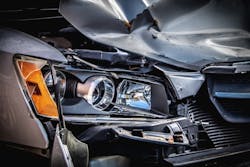Aug. 12, 2021—Telematics, at its core, is about communication.
In vehicles, a telematic system is designed to take data from sensors and cameras and turn that into useful information for a driver, manager or repairer. It seems to make sense, then, that one of the largest conversations surrounding emerging telematics technologies in the collision industry focuses on communication.
During a recent seminar hosted by the Collision Industry Conference, several experts in the field discussed not only how telematic systems should communicate with a driver, but also how insurers, OEMs and repairers should communicate with drivers about their telematic systems.
Scott Biggs, CEO of Assured Performance, likened the evolution of technology in vehicles more closely to the progression of cell phones than what the development of automobiles has been like in years passed.
Telematics enables consumers to connect to their car, and most of the telematics will be an evolution like smart apps that are intuitive, automated and push information that will be useful, so long as there aren’t incumbents that control the data right now who put up roadblocks to progress.
“When you have technology that can do a lot of things, there will be innovators…and it will become much more pervasive through everything, but it has to be intuitive,” Biggs says. “If it isn’t intuitive, people won’t use it.”
Because of that, the panel agreed, the focus on emerging telematics in the collision industry should be on how customers are educated about their vehicles, what their telematic systems do and how they should operate in the event of an accident.
There are a ton of options that exist today that are built into your car and into your phone. In the case of an accident, are you getting notifications from your car, from your phone, from a specific app, or all of the above?
There are a lot of different tech companies who are figuring out solutions through a variety of different ways to capture that info and to identify when an accident has occurred. Because of that, it can be hard for a customer to know where their data is being sent.
“Telematics in the shop is a daily conversation with the customers. We need to have a process of educating the guest, letting them know what we’re doing to their vehicle,” says Rob Grieve, owner of Nylund’s Collision Center.
Due to that lack of clarity, the field of telematics is almost like the Wild West. Biggs says the industry is still in the early stages of what telematics can do and how they can be used efficiently. OEMs, insurance companies and repairers all want to be the first to receive notification of damage and control where a car goes, but that isn’t always the best option for the driver.
There is a push for customer-first practices, but Biggs says that needs to become more widespread.
“There may be perceived competition right now about who gets first notice of loss, but we’re starting to see those lines blur,” he says. “Ultimately, the goal should be getting the consumer to a place where they can fix their vehicle and make that as easy as possible.”
Instead of debating where the car goes first between themselves, OEMs and insurance should work with the driver to make sure their gets to the right shop the first time, that they only have to have it towed once instead of multiple times and that the driver is assured their car is getting sent to the shop that is best equipped to fix it.
Essentially, the ultimate goal should be to get the car back to the consumer as fast, efficiently and affordably as possible.
“What if the consumer had the first notification of loss? What if telematics worked to make sure it told the customer their car is safe to drive and everything was in working order?” Biggs asks. “When that happens, it’s going to force insurers, repairers and OEMs to get on the same side and start fixing cars correctly. Then they can negotiate and argue about price. You have to unbuckle the ‘how to’ from the ‘how much.’ Proper repair is non-negotiable, and that will cure a lot of our industry’s problems.”
Image: Clark Van Der Beken
About the Author
FenderBender Staff Reporters
The FenderBender staff reporters have nearly four decades of combined journalism and collision repair experience.
